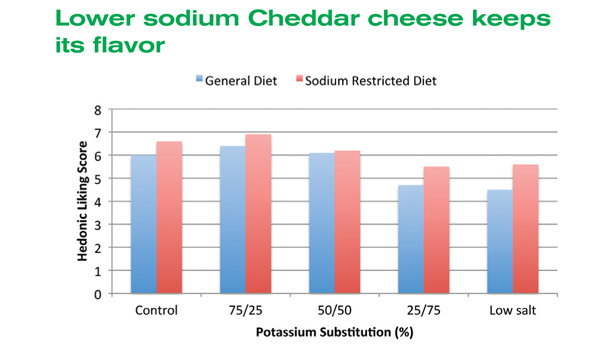Sodium under scrutiny
Many thought (and some said) it couldn’t be done. However, the dairy industry is making strides in manufacturing lower-sodium cheese that sells.

One approach to maintaining acceptable flavor is to mix lower-sodium cheese shreds with regular cheese shreds.

Sensory profile scores for Cheddar cheeses that were made with 25%, 50% or 75% substitution of sodium chloride with potassium chloride are compared to a control cheese containing 1.7% salt and a low sodium cheese containing only 0.7% salt. Cheeses were made at the Western Dairy Center and flavor testing performed at the Southeast Dairy Foods Research Center. Bitter flavor that was absent in the control cheese increased with added potassium but were still at a low level.

Consumers on a restricted-salt diet or on a regular diet rated Cheddar cheeses made using the normal amount of salt (control), and those using a 75/25, 50/50 or 25/75 ratio of sodium chloride and potassium chloride or salted at a low salt level.
Scores above 5 show increased liking while scores below 5 indicate a consumer dislike for the cheeses.



But why even try? Why not pick on foods where the function of salt isn’t so fundamental? Good question, but one that was pre-empted by across-the-board sodium reduction initiatives.
Concerned about the health of U.S. citizens consuming 3,400 milligrams of sodium per day (on average), the Food and Drug Administration is considering setting mandatory maximums for sodium in food. In the United States, the main sodium reduction program is the National Salt Reduction Initiative (NSRI) led by the New York City Department of Health.
Is sodium a scapegoat? It is an essential nutrient. However, in a subset of the population, consuming too much sodium has been linked to hypertension, a risk factor for heart disease, stroke and kidney disease. But beyond the subset, some health experts see sodium as public enemy number one due to the population’s high rate of hypertension and “high” sodium consumption — even though other factors affect blood pressure such as genetics and lifestyle.
In reality, no one knows if a population-wide reduction in sodium intake will reduce the prevalence of hypertension. And no one knows if overly restrictive policies to reduce sodium intake will lead to unintended negative consequences such as nutrient deficiencies.
Scientists do know that the Dietary Approaches to Stop Hypertension (DASH) diet, a low-fat eating plan containing two to three servings of low-fat and/or reduced-fat dairy foods (including cheese), has been shown to effectively lower blood pressure regardless of sodium content.
Contributing 8% to the average U.S. sodium intake,
cheese isn’t a major source of sodium. Plus, it provides calcium, phosphorus and protein — nutrients linked to lower blood pressure.
Nonetheless, noting the increased scrutiny of salt, dairy industry stakeholders took the offensive, according to Nigel Kirtley, vice president, Cheese Research, Development and Quality, Kraft Foods, Northfield, Ill.; and the Cheese and Sodium Best Practices Task Force of the Innovation Center for U.S. Dairy, Rosemont, Ill.
Created in 2009, the task force brought together cheesemakers and dairy industry partners on a pre-competitive basis to address cheese and sodium in three areas: maintaining taste and functionality in lower-sodium cheese products; sodium testing and updating manufacturing process controls; and education/outreach about cheese and health. Here’s a sampling of the industry’s progress to date.
Establishing a sodium baseline
The task force’s first step was to gain a better understanding of the sodium levels in cheese, said Gregory Miller, president, Dairy Research Institute, and executive vice president, National Dairy Council. A national survey, published in the Journal of Dairy Science (2011), found great variability in the sodium content of Cheddar, mozzarella and process cheese depending on type, brand, form and sample — pinpointing a need for best practices for sodium use during the manufacturing process. Miller noted that dairy research centers are a resource to assist manufacturers with best practices.
Improving sodium testing
Sources of sodium in the U.S. diet |
|
The estimated average daily sodium intake per person in the U.S. is 3,400 milligrams. The recommended daily sodium intake for the general healthy population is 2,300 milligrams, according to the 2010 Dietary Guidelines for Americans. But for those with hypertension, diabetes or chronic kidney disease as well as African Americans and adults over 50 years of age, the recommendation is 1,500 milligrams or less per day. The major sources of dietary sodium are processed foods, for example, canned foods, luncheon meats, breads and baked goods, and foods served in restaurants. The American Heart Association’s “Salty Six” are breads and rolls, cold cuts and cured meats, pizza, poultry, soup and sandwiches. Although 65% of consumers are very/extremely concerned about sodium, only 10% to 32% are considered “sodium restrictors,” and cheese ranks low on their list of foods to avoid, according to the Innovation Center for U.S. Dairy. |
To improve process control, sodium must be quickly and accurately measured.
“[The industry] is measuring sodium in an indirect way and not using the data to manage or control processes,” said Kirtley. “We realized that we need to use sodium as efficiently as we possibly can.”
The task force is working with vendors to develop and validate equipment/procedures for rapid sodium testing. Miller reported that proof concepts tests were successful and equipment trials will take place this summer.
Donald McMahon and MaryAnne Drake have researched consumer satisfaction of Cheddar cheese with less salt. McMahon is the director of the Western Dairy Center at Utah State University and Drake is with the Southeast Dairy Foods Research Center at North Carolina State University. They found that consumers’ liking of cheese was the same when sodium was decreased by 25%, but liking decreased when more than 33% of the sodium was removed. Also, lowering sodium in Cheddar cheese by one-third showed no significant impact on food safety.
McMahon and Drake also discovered that, in general, consumers like cheese just as much when up to 25% of the sodium chloride is substituted with potassium chloride (KCl). Drawbacks include KCl’s bitterness, added expense, need for better process control and labeling considerations.
Kathy Glass, associate director and senior scientist in the Food Research Institute at the University of Wisconsin-Madison, is investigating adding ingredients to cheese to inhibit bacterial growth. Mark Johnson, senior scientist at the Wisconsin Center for Dairy Research, is working on formulating tastier lower-sodium cheese for pizza served in schools by adding whey ingredients that impart saltiness and sweetness.
“Five years ago, I would say there was no way we could develop an acceptable reduced sodium Cheddar cheese,” said Johnson. “But with the technology available now, we can make a reduced sodium Cheddar that’s not equivalent to regular cheese but is a purchasable item for selected markets.”
The industry is also looking at the use of non-mineral emulsifiers and mixing and matching cheeses. Miller said that recent research shows promise for the use of non-mineral emulsifiers, such as mono- and diglycerides, in place of sodium-based emulsifiers during processing, especially with processed cheese.
Consumer acceptance of reduced-sodium cheese continues to be a challenge, Kirtley admitted. Still, he said he feels “really good” about the progress the dairy industry has made in four years, moving from the stance that “this doesn’t affect us” to “we have to be proactive and part of the solution. We haven’t put our head in the sand. The CDC, FDA and USDA realize the dairy industry has done a lot in this area.”
Looking for a reprint of this article?
From high-res PDFs to custom plaques, order your copy today!








